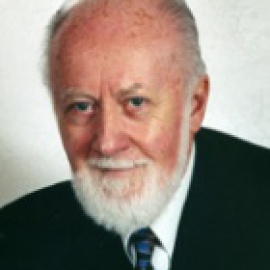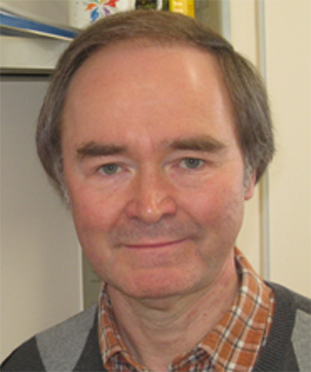Tiller - Realm Between Particles Influenced by Consciousness
Inhoud
1. William Tiller - Vast, Powerful Realm Between Particles Influenced by Human Consciousness
2. Bernard Carr - Where Do Our Thoughts Physically Exist?
3. Bernard Carr - Astronomer Says Spiritual Phenomena Exist in Other Dimensions
4. Dean Radin - Our Thoughts Transcend Time?
1. Stanford Scientist: Vast, Powerful Realm Between Particles Influenced by Human Consciousness
By Tara MacIsaac,
Epoch Times, March 1, 2014
Philosophers have wondered for ages how mind and matter relate to each other, and modern physics is chiming in on the debate.
Here's a look at a few theories about where or in what way our thoughts physically exist.
Vast Realm Between Particles

William A. Tiller
Tiller hypothesizes that our thoughts have a physical effect on a "new level of substance … which appears to function in the physical vacuum (the empty space between the fundamental particles that make up our normal atoms and molecules)."
He says he has been able to measure this hitherto invisible substance, but only when it interacts with the substances we can conventionally measure. This interaction seems to occur when spurred by human intention, suggesting our thoughts physically exist in this realm.
He says two kinds of substances exist:
1. The atom/molecule level: Substances on this level can be measured with traditional instruments. We can measure them because they are electric-charge based.
2. The magnetic information waves level: Tiller explains in an introduction to his research on his website: "This new level of substance, because it appears to function in the physical vacuum (the empty space between the fundamental particles that make up our normal atoms and molecules), is currently in-visible to us and to our traditional measurement instruments."
This second type of substance has great power, and it is affected by human thought.
Power of the Magnetic Information Waves

Albert Einstein
The latent energy in one atom is a trillion times that estimated to exist in the space of the known univer-se.
"Just that little bit of vacuum outweighs all the mass and all the planets and all the stars," he said. This comparison assumes the universe is fairly flat [homogeneous], which astronomers say it is. Tiller said the calculations are not 100 percent accurate, but they are accurate enough to give us an idea of the amount of energy in this second type of substance he talks about in the vacuum.
How Human Intention Takes Effect
Tiller says he has been able to detect this hitherto invisible substance, but only when it interacts with the molecule/atom type substance we can conventionally measure.
Human consciousness spurs this interaction.
An intention projected from a person's mind seems to increase the conductivity between the at-om/molecule level and the vacuum level.
"Consciousness lifts the higher thermodynamic free energy state [of the vacuum level], then we can ac-cess the physics of the vacuum," Tiller says. "Accessing that new physics allows intention to bring forth effects you wouldn't imagine."
The consciousness can, in a way, affect or interact with a power greater than anything conventional in-struments have been able to measure thus far.
terug naar de Inhoud
2. Where Do Our Thoughts Physically Exist?
By Tara MacIsaac
Epoch Times, May 6, 2014
Noosphere, Related to the Internet
Teilhard de Chardin, a Jesuit priest and paleontologist, wrote of a conceptual 'noosphere' in the first half of the 20th century. He predicted that at a future stage of humanity's development a membrane containing our collective thoughts and experiences would envelope the world.
In 'The Phenomenon of Man' he wrote: "Is this not like some great body which is being born - with its limbs, its nervous system, its perceptive organs, its memory - the body in fact of that great living Thing which had to come to fulfill the ambitions aroused in the reflective being by the newly acquired consciousness?"
Many have made a connection between De Chardin's noosphere and the Internet. Could the Internet be considered a realm in which our collective consciousness exists?
Thoughts Exist in Other Physical Dimensions

Bernard Carr
(Wikimedia Commons)
Carr reasons that our physical sensors only show us a 3-dimensional universe, though there are actually at least four dimensions. What exists in the higher dimensions are entities we cannot touch with our physical sensors. He said that such entities must still have a type of space in which to exist.
"The only non-physical entities in the universe of which we have any experience are mental ones, and … the existence of paranormal phenomena suggests that mental entities have to exist in some sort of space," Carr wrote.
Read more about Carr's theories: "Astronomer Says Spiritual Phenomena Exist in Other Dimensions" below.
terug naar de Inhoud
3. Astronomer Says Spiritual Phenomena Exist in Other Dimensions
By Tara MacIsaac
Epoch Times, April 7, 2014
Astronomer and mathematician Bernard Carr theorizes that many of the phenomena we experience but cannot explain within the physical laws of this dimension, actually occur in other dimensions.
Bernard Carr (Wikimedia Commons)
Albert Einstein stated that there are at least four dimensions. The fourth dimension is time, or spacetime, since Einstein said space and time cannot be separated. In modern physics, theories about the existence of up to 11 dimensions and the possibility of more, have gained traction.
Carr, a professor of mathematics and astronomy at Queen Mary University of London, says our consciousness interacts with another dimension. Furthermore, the multi-dimensional universe he envisions has a hierarchical structure. We are at the lowest-level dimension.
"The model resolves wellknown philosophical problems concerning the relationship between matter and mind, elucidates the nature of time, and provides an ontological framework for the interpretation of phenomena such as apparitions, OBEs [out-of-body experiences], NDEs [near-death-experiences], and dreams," he wrote in a conference abstract.
Carr reasons that our physical sensors only show us a 3-dimensional universe, though there are actually at least four dimensions. What exists in the higher dimensions are entities we cannot touch with our physical sensors. He said that such entities must still have a type of space to exist in.
"The only non-physical entities in the universe of which we have any experience are mental ones, and … the existence of paranormal phenomena suggests that mental entities have to exist in some sort of space," Carr wrote.
The other-dimensional space we enter in dreams overlaps with the space where memory exists. Carr says telepathy signals a communal mental space and clairvoyance also contains a physical space. "Non-physical percepts have attributes of externality," he wrote in his book 'Matter, Mind, and Higher Dimen-sions.'
He builds on previous theories, including the Kaluza–Klein theory, which unifies the fundamental forces of gravitation and electromagnetism. The Kaluza–Klein theory also envisions a 5-dimensional spa-ce.
In 'M-theory' there are 11 dimensions. In superstring theory, there are 10. Carr understands this as a 4-dimensional 'external' space - meaning these are the four dimensions in Einstein's relativity theory - and a 6- or 7-dimensional 'internal' space - meaning these dimensions relate to psychic and other 'intangible' phenomena.
terug naar de Inhoud
4. Our Thoughts Transcend Time?
Dean Radin, PhD, has done studies to show our thoughts may have an effect on physical reality, but it may not be in the present or future as we expect. It is possible that our thoughts in the future affect our past reality, he says.
Radin is the chief scientist at the Institute of Noetic Sciences, a non-profit organization founded by Apollo 14 astronaut Edgar Mitchell and dedicated to consciousness research. Radin is also adjunct faculty in the department of psychology at Sonoma State University and he has held appointments at Princeton University and several Silicon Valley think-tanks among other institutions.
He has tested the ability of human intention to affect physical reality using a random number generator (RNG). He is not the only scientist who has used an RNG to test mind-matter interaction, but he is unique in his focus on the ability of future intentions to affect the past.
Most RNG tests focus on a forward-in-time, standard cause-effect model. A person has an intention and it is expected to affect the future result, or number generated. Radin opened his experiment to the idea that a future intention may affect past results and found "the observed results may be better modeled as a process running backwards in time from a future 'target', rather than as a more complex process running forward in time trying to hit that target," according to his study published in the Journal of Scientific Exploration in 2006.
"Some forms of apparent MMI [mind-matter interaction] may involve processes that are more consistent with retrocausal 'pulls' from the future than with causal 'pushes' from the present."
terug naar het literatuuroverzicht
terug naar het weblog
^